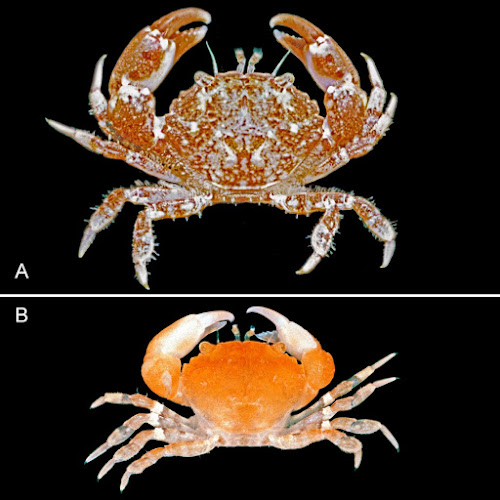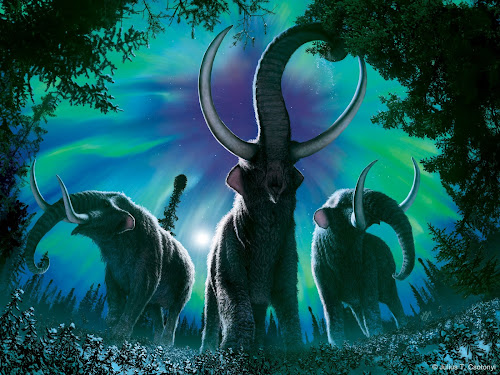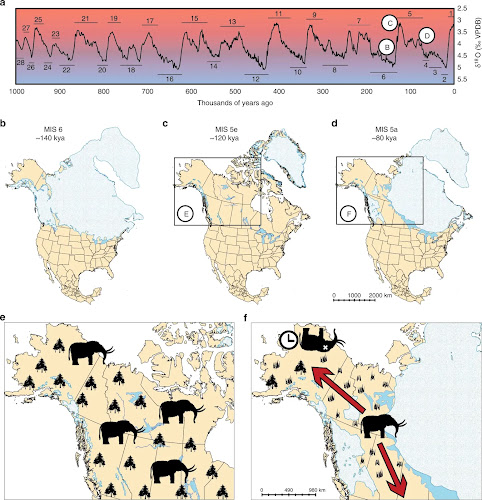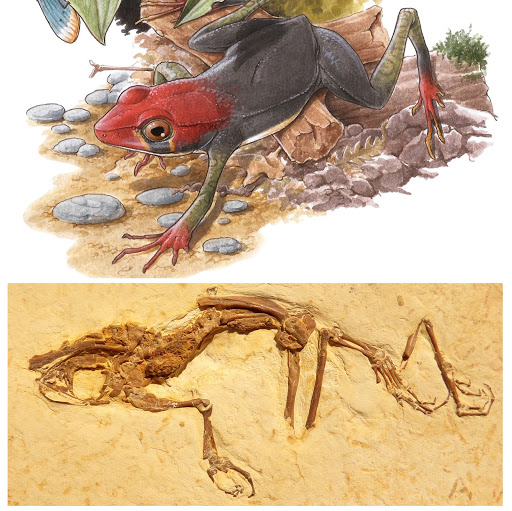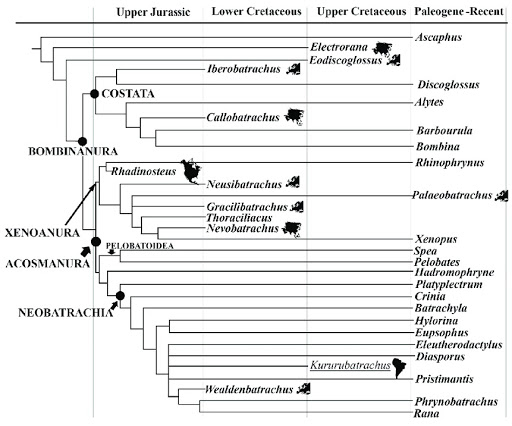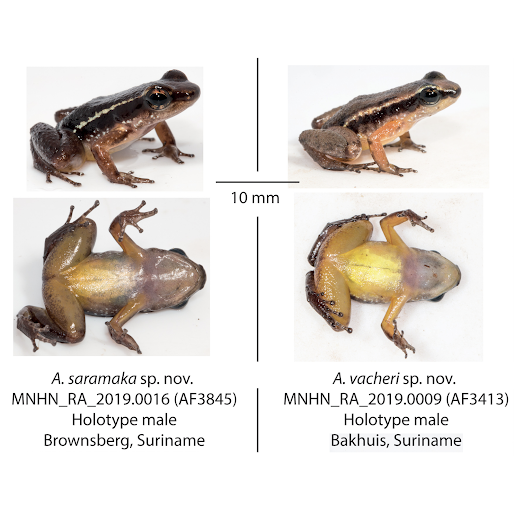[Most Recent Entries] [Calendar View]
Thursday, September 3rd, 2020
| Time | Event | ||||||
| 8:18a | [Crustacea • 2020] Lithopanopeus truesdalei • A New Genus and Species of Mud Crab (Brachyura, Panopeidae) from Shoreline Waters of the western Gulf of Mexico
Abstract Several specimens of a small panopeid crab from coastal waters of the western Gulf of Mexico were long suspected to represent an undescribed species and are herein designated as representatives of a new genus. While the originally collected specimens from over four decades ago were not of gene-sequence quality, later collections from the same locality produced materials that yielded sequence data for inclusion in molecular phylogenetic studies. Building on results of those analyses, the present taxonomic description draws upon morphology to support the description of a unique species in which especially the male first gonopods differ from those of all other described panopeid genera. To date, the species remains known from only two western Gulf of Mexico sites, both of which are wave-washed intertidal rocky habitats where substrates are heavily burrowed by boring bivalves and sipunculans. While we cannot exclude the possibility that the species was introduced, recurrent collections show its populations to be at very least persistent, the species most likely being a long-overlooked among a confusing hard-substrate assemblage of small panopeid crabs. Keywords: Crustacea, Xanthoidea, mud crab, western Atlantic, shoreline Taxonomy Superfamily Xanthoidea MacLeay, 1838 Family Panopeidae Ortmann, 1893 Lithopanopeus n. gen. Type species. Lithopanopeus truesdalei n. sp., by present designation. Diagnosis. Carapace outline ovoid to subhexagonal, length about ¾ greatest width (including lateral extremes of anterolateral teeth, slightly less in large females), fronto-orbital width less than ¾ greatest carapace width, front more than twice width of orbit, with deep median V-shaped notch, laterally forming lobiform tooth; dorsal surface appearing nearly smooth with scattered fine granules, coarser near margins, across front, or where forming rows across anterior carapace regions; areolations weakly marked, separated at most by shallow depressed furrows anteriorly, anterior regions surmounted by elongate ridges of low granules; anterolateral margin with five distinct anterolateral teeth (counting as first the outer orbital), second anterolateral tooth rounded subtriangular to lobiform, partially coalesced to first tooth, third and fourth teeth subtriangular, acute to subacute tips directed anteriorly to anterolaterally, fifth tooth smallest, distinctly developed, subtriangular; lacking subhepatic tubercle below margin. Eyestalk short, ending in globular cornea about width of eyestalk shaft. Distalmost article of antennal peduncle elongate, rectangular in outline, reaching to and filling orbit hiatus. Chelipeds unequal, dorsal surface finely granulate with some enlarged granules in short rows and ridges; carpus dorsal surface irregular, distal furrow extending from superior to distolateral surface, deeply depressed, inner corner marked by enlarged blunt, distally directed tooth; propodus upper surface weakly convex longitudinally, granulation slightly coarser, some in short transverse rows dorsally, weakly defined broken dorsal furrow between very low to obsolete longitudinal ridge to internal side and stronger rounded longitudinal ridge to external side; major chela dactylus opposable margin bearing enlarged, lobiform, basal tooth. Ambulatory pereopod merus, carpus, and propodus superior margin bearing narrow tract of subacute granules or small tubercles, superior margin of merus including row of long, closely set, plumose, feathery setae, these less dense on more distal articles, distalmost articles bearing broad tracks of very short, densely plumose setae on margins, densest on inferior and especially superior surface of dactylus; dactylar-propodal locking mechanism not developed, dactyl inferior margin lacking calcareous prehensile tooth. Male thoracic sternum length from apex to suture between fourth and fifth sternites (measured at edge of pleon near or exceeding 0.7 greatest width of fourth sternite (including episternites), sternopleonal cavity in fourth sternite not sculpted or excavate to accommodate first gonopod tips; fifth sternite with granulate press button to each side of sternopleonal cavity; male pleonal margins thick, reflected toward thoracic sternum, edges appearing heavy, press-button depression deep, thick; third to fifth somites of male pleon fused, second somite spanning almost full width of sternum, narrow tract of eighth sternite exposed between lateral margin and condyle of fifth pereopod coxa, third somite about 1.2 width of second, lateral flange reaching to base of fifth peropod condyle. Male first gonopod tip of modified trifid panopeid form, sternomesial side of trunk lined by heavy teeth in distal half and subterminally with broad, acute, bladelike subterminal tooth. Male second gonopod less than 1/3 length of first. Female gonopore (including opening and surrounding lips or vulva) centered in anterior half of sixth thoracic sternite, in spanning more than half of sixth thoracic sternite adjacent length. Etymology. The generic name Lithopanopeus merges the prefix “litho”, for its rocky habitat, with the suffix “panopeus”, derived from the type genus of Panopeidae. The gender is masculine. The few known specimens all have been found in association with calcareous intertidal rocks eroded by burrowing molluscs and sipunculan worms. Appropriately, the species bears close general resemblance to a number of other small panopeid crabs. Lithopanopeus truesdalei n. gen., n. sp. Hexapanopeus nov. sp.—Thoma et al. 2009: 554, table 2, 558, fig. 1, 559, fig. 2, 560. Nov. gen. nov. sp. near Acantholobulus schmitti.—Thoma et al. 2014: 92, fig. 1. Gen. nov., sp. nov. near A. schmitti.—Thoma et al. 2014: 90, table 1, 98. Etymology. The species name is assigned in recognition of Frank M. Truesdale for his many contributions to crustacean biology through his personal research and training of students, but also in gratitude for many years of supportive assistance and collaborations with DLF and his students. In addition to his renowned compilations on the history of carcinological research, his special expertise in the rearing of decapod larvae has contributed substantially to understanding of decapod crustacean life histories, including those of panopeid crabs. Distribution. Brazos Santiago Inlet in extreme south Texas and a natural rocky shoreline platform along Playa de la Mancha, Veracruz, Mexico. Darryl L. Felder and Brent P. Thoma. 2020. A New Genus and Species of Mud Crab (Crustacea, Brachyura, Panopeidae) from Shoreline Waters of the western Gulf of Mexico. Zootaxa. 4845(3); 425–435. DOI: 10.11646/zootaxa.4845.3.7 | ||||||
| 9:21a | [PaleoMammalogy • 2020] American Mastodon Mammut americanum Mitochondrial Genomes Suggest Multiple Dispersal Events in Response to Pleistocene Climate Oscillations Abstract Pleistocene glacial-interglacial cycles are correlated with dramatic temperature oscillations. Examining how species responded to these natural fluctuations can provide valuable insights into the impacts of present-day anthropogenic climate change. Here we present a phylogeographic study of the extinct American mastodon (Mammut americanum), based on 35 complete mitochondrial genomes. These data reveal the presence of multiple lineages within this species, including two distinct clades from eastern Beringia. Our molecular date estimates suggest that these clades arose at different times, supporting a pattern of repeated northern expansion and local extirpation in response to glacial cycling. Consistent with this hypothesis, we also note lower levels of genetic diversity among northern mastodons than in endemic clades south of the continental ice sheets. The results of our study highlight the complex relationships between population dispersals and climate change, and can provide testable hypotheses for extant species expected to experience substantial biogeographic impacts from rising temperatures. Emil Karpinski, Dirk Hackenberger, Grant Zazula, Chris Widga, Ana T. Duggan, G. Brian Golding, Melanie Kuch, Jennifer Klunk, Christopher N. Jass, Pam Groves, Patrick Druckenmiller, Blaine W. Schubert, Joaquin Arroyo-Cabrales, William F. Simpson, John W. Hoganson, Daniel C. Fisher, Simon Y. W. Ho, Ross D. E. MacPhee and Hendrik N. Poinar. 2020. American Mastodon Mitochondrial Genomes Suggest Multiple Dispersal Events in Response to Pleistocene Climate Oscillations. Nature Communications. 11: 4048. DOI: 10.1038/s41467-020-17893-z | ||||||
| 10:33a | [Paleontology • 2020] Kururubatrachus gondwanicus • Early Cretaceous Neobatrachian Frog (Anura) from Brazil sheds light on the Origin of Modern Anurans
Highlights: • A new neobatrachian anuran coming from the Early Cretaceous (Aptian) Crato Formation from Brazil is described. • Present record constitutes an important addition to the scarse fossils of Mesozoic anurans in South America. • Present finding indicates that modern frog clades were well-diversified by 40 million years before the K/T boundary. • In Patagonia, the K/T boundary does not accounts for a massive anuran extinction. Abstract The fossil record of anurans in South America is scarse, especially for Mesozoic-aged beds. The aim of the present paper is to describe a new neobatrachian anuran coming from the Early Cretaceous (Aptian) Crato Formation from Brazil. The specimen, represented by a nearly complete skeleton is reminiscent to the extant clade Hyloidea. In contrast with recent claims, this finding, together with previously known fossils from South America indicates that modern frog clades were present and well-diversified by 40 million years before the K/T boundary. In the same sense, the analysis of Mesozoic and Paleogene anuran record in South America contradicts the hypothesis of massive anuran extinction at the K/T boundary. Keywords: Anura, Neobatrachia, Early Cretaceous, Crato formation, Brazil Anura Fischer von Waldheim, 1813 Neobatrachia Reig, 1958. Kururubatrachus nov. gen. Etymology. Kururu, is the common name of a living species of South American toad (Rhinella schneideri) but also, according a legend of the tupí-guaraní culture, is the animal that brings the fire to humans during the creation of the world; batrachus is the Latin word for “toad” Kururubatrachus gondwanicus nov. sp. Etymology. The species name, gondwanicus, comes from the Gondwanan context of the Araripe Basin.
Conclusions: We describe here the new fossil and species of anuran Kururubatrachus gondwanicus nov. gen. et sp., coming from the Early Cretaceous (Aptian) Crato Formation from Brazil. The specimen, represented by a nearly complete and articulated skeleton belongs to Neobatrachia, and it is reminiscent to the extant clade Hyloidea. Further, a brief overview on the fossil record of anurans indicate that several relevant reports have been overlooked by previous literature (e.g., Báez and Gómez, 2017; Báez et al., 2009, 2012; Agnolin, 2012). These, reinforce previous ideas of an old diversification of neobatrachians deep in the Cretaceous period. As for example, in spite of the poor fossil record in Patagonia, members of Calyptocephalellidae appear to be abundant and well-diversified in the Maastrichtian. Further, the diverse fossil record of neobatrachians from Crato indicates that modern frogs were present and well-diversified by 40 million year before the K/T boundary, countering recent proposals that sustain a postK/T diversification of main modern anuran clades. In addition, in spite of the sketchy fossil record, by Late Cretaceous times, members of Pipoidea and Calyptocephalellidae are well represented in Patagonia. Remarkably, both clades survive the K/T and remain relatively diverse and abundant during Paleogene times. This indicates that anurans from Patagonia (at least) were probably not strongly affected by the extinction event at the K/T boundary. Federico Agnolin, Ismar de Souza Carvalho, Alexis M. Aranciaga Rolando, Fernando E. Novas, José Xavier-Neto, José Artur Ferreira Gomes Andrade and Francisco Idalécio Freitas. 2020. Early Cretaceous Neobatrachian Frog (Anura) from Brazil sheds light on the Origin of Modern Anurans. Journal of South American Earth Sciences. 101, 102633. DOI: 10.1016/j.jsames.2020.102633 | ||||||
| 10:54a | [Herpetology • 2020] Anomaloglossus saramaka & A. vacheri • Two New Species of Anomaloglossus (Anura: Aromobatidae) of the A. stepheni group from Suriname
Abstract Anomaloglossus is a species-rich genus of frogs endemic to the Guiana Shield that still harbours several unnamed species. According to a recent integrative taxonomic survey, the A. stepheni species group includes five valid nominal species and at least four putatively unnamed species, two in Brazil and two in Suriname. In this paper, we describe the two species from Suriname based on adult and tadpole morphology as well as their calls and natural history. Both have exotrophic tadpoles transported by the male to small water bodies. These two new species differ from each other and from other congeners in body size, colouration pattern, call characteristics and breeding sites. Both have narrow distributions and should be considered Endangered according to IUCN criteria. Keywords: Amazonia, Conservation, Endemism, Guiana Shield, Taxonomy Anomaloglossus saramaka sp. nov. Etymology. The specific epithet is a noun in apposition and refers to the Saramaka people who live nearby the type locality and are one of the Maroon communities living in Suriname. Anomaloglossus vacheri sp. nov. Etymology. This species is dedicated to Jean-Pierre Vacher, in honour of his strong contribution to the understanding of the diversity and the evolution of the genus Anomaloglossus. Antoine Fouquet, Rawien Jairam, Paul Ouboter and Philippe J. R. Kok. 2020. Two New Species of Anomaloglossus (Anura: Aromobatidae) of the stepheni group from Suriname. Zootaxa. 4820(1); 147–164. DOI: 10.11646/zootaxa.4820.1.7 |
| << Previous Day |
2020/09/03 [Calendar] |
Next Day >> |
